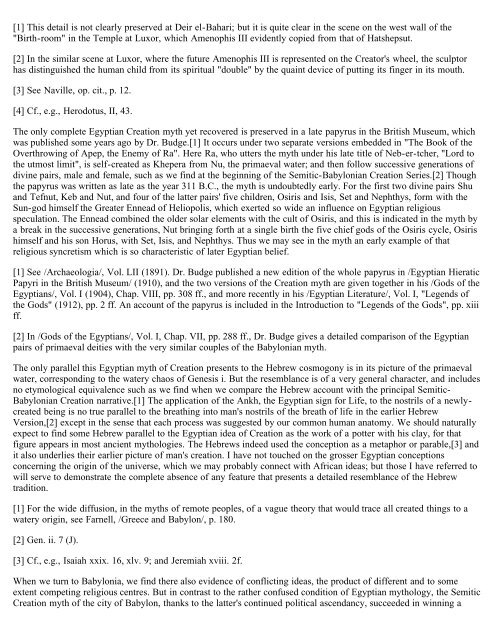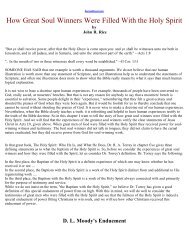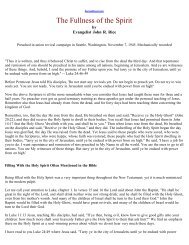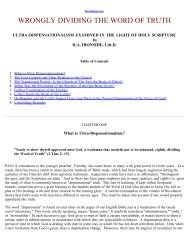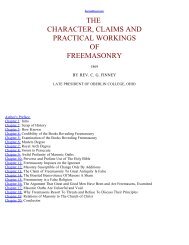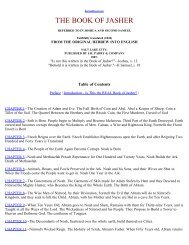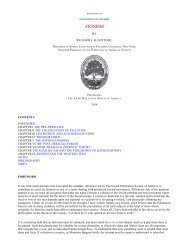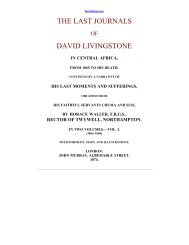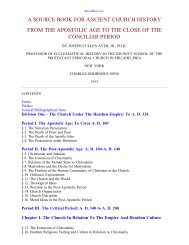Legends of Babylon and Egypt in Relation to Hebrew Tradition.pdf
Legends of Babylon and Egypt in Relation to Hebrew Tradition.pdf
Legends of Babylon and Egypt in Relation to Hebrew Tradition.pdf
You also want an ePaper? Increase the reach of your titles
YUMPU automatically turns print PDFs into web optimized ePapers that Google loves.
[1] This detail is not clearly preserved at Deir el-Bahari; but it is quite clear <strong>in</strong> the scene on the west wall <strong>of</strong> the<br />
"Birth-room" <strong>in</strong> the Temple at Luxor, which Amenophis III evidently copied from that <strong>of</strong> Hatshepsut.<br />
[2] In the similar scene at Luxor, where the future Amenophis III is represented on the Crea<strong>to</strong>r's wheel, the sculp<strong>to</strong>r<br />
has dist<strong>in</strong>guished the human child from its spiritual "double" by the qua<strong>in</strong>t device <strong>of</strong> putt<strong>in</strong>g its f<strong>in</strong>ger <strong>in</strong> its mouth.<br />
[3] See Naville, op. cit., p. 12.<br />
[4] Cf., e.g., Herodotus, II, 43.<br />
The only complete <strong>Egypt</strong>ian Creation myth yet recovered is preserved <strong>in</strong> a late papyrus <strong>in</strong> the British Museum, which<br />
was published some years ago by Dr. Budge.[1] It occurs under two separate versions embedded <strong>in</strong> "The Book <strong>of</strong> the<br />
Overthrow<strong>in</strong>g <strong>of</strong> Apep, the Enemy <strong>of</strong> Ra". Here Ra, who utters the myth under his late title <strong>of</strong> Neb-er-tcher, "Lord <strong>to</strong><br />
the utmost limit", is self-created as Khepera from Nu, the primaeval water; <strong>and</strong> then follow successive generations <strong>of</strong><br />
div<strong>in</strong>e pairs, male <strong>and</strong> female, such as we f<strong>in</strong>d at the beg<strong>in</strong>n<strong>in</strong>g <strong>of</strong> the Semitic-<strong>Babylon</strong>ian Creation Series.[2] Though<br />
the papyrus was written as late as the year 311 B.C., the myth is undoubtedly early. For the first two div<strong>in</strong>e pairs Shu<br />
<strong>and</strong> Tefnut, Keb <strong>and</strong> Nut, <strong>and</strong> four <strong>of</strong> the latter pairs' five children, Osiris <strong>and</strong> Isis, Set <strong>and</strong> Nephthys, form with the<br />
Sun-god himself the Greater Ennead <strong>of</strong> Heliopolis, which exerted so wide an <strong>in</strong>fluence on <strong>Egypt</strong>ian religious<br />
speculation. The Ennead comb<strong>in</strong>ed the older solar elements with the cult <strong>of</strong> Osiris, <strong>and</strong> this is <strong>in</strong>dicated <strong>in</strong> the myth by<br />
a break <strong>in</strong> the successive generations, Nut br<strong>in</strong>g<strong>in</strong>g forth at a s<strong>in</strong>gle birth the five chief gods <strong>of</strong> the Osiris cycle, Osiris<br />
himself <strong>and</strong> his son Horus, with Set, Isis, <strong>and</strong> Nephthys. Thus we may see <strong>in</strong> the myth an early example <strong>of</strong> that<br />
religious syncretism which is so characteristic <strong>of</strong> later <strong>Egypt</strong>ian belief.<br />
[1] See /Archaeologia/, Vol. LII (1891). Dr. Budge published a new edition <strong>of</strong> the whole papyrus <strong>in</strong> /<strong>Egypt</strong>ian Hieratic<br />
Papyri <strong>in</strong> the British Museum/ (1910), <strong>and</strong> the two versions <strong>of</strong> the Creation myth are given <strong>to</strong>gether <strong>in</strong> his /Gods <strong>of</strong> the<br />
<strong>Egypt</strong>ians/, Vol. I (1904), Chap. VIII, pp. 308 ff., <strong>and</strong> more recently <strong>in</strong> his /<strong>Egypt</strong>ian Literature/, Vol. I, "<strong>Legends</strong> <strong>of</strong><br />
the Gods" (1912), pp. 2 ff. An account <strong>of</strong> the papyrus is <strong>in</strong>cluded <strong>in</strong> the Introduction <strong>to</strong> "<strong>Legends</strong> <strong>of</strong> the Gods", pp. xiii<br />
ff.<br />
[2] In /Gods <strong>of</strong> the <strong>Egypt</strong>ians/, Vol. I, Chap. VII, pp. 288 ff., Dr. Budge gives a detailed comparison <strong>of</strong> the <strong>Egypt</strong>ian<br />
pairs <strong>of</strong> primaeval deities with the very similar couples <strong>of</strong> the <strong>Babylon</strong>ian myth.<br />
The only parallel this <strong>Egypt</strong>ian myth <strong>of</strong> Creation presents <strong>to</strong> the <strong>Hebrew</strong> cosmogony is <strong>in</strong> its picture <strong>of</strong> the primaeval<br />
water, correspond<strong>in</strong>g <strong>to</strong> the watery chaos <strong>of</strong> Genesis i. But the resemblance is <strong>of</strong> a very general character, <strong>and</strong> <strong>in</strong>cludes<br />
no etymological equivalence such as we f<strong>in</strong>d when we compare the <strong>Hebrew</strong> account with the pr<strong>in</strong>cipal Semitic-<br />
<strong>Babylon</strong>ian Creation narrative.[1] The application <strong>of</strong> the Ankh, the <strong>Egypt</strong>ian sign for Life, <strong>to</strong> the nostrils <strong>of</strong> a newlycreated<br />
be<strong>in</strong>g is no true parallel <strong>to</strong> the breath<strong>in</strong>g <strong>in</strong><strong>to</strong> man's nostrils <strong>of</strong> the breath <strong>of</strong> life <strong>in</strong> the earlier <strong>Hebrew</strong><br />
Version,[2] except <strong>in</strong> the sense that each process was suggested by our common human ana<strong>to</strong>my. We should naturally<br />
expect <strong>to</strong> f<strong>in</strong>d some <strong>Hebrew</strong> parallel <strong>to</strong> the <strong>Egypt</strong>ian idea <strong>of</strong> Creation as the work <strong>of</strong> a potter with his clay, for that<br />
figure appears <strong>in</strong> most ancient mythologies. The <strong>Hebrew</strong>s <strong>in</strong>deed used the conception as a metaphor or parable,[3] <strong>and</strong><br />
it also underlies their earlier picture <strong>of</strong> man's creation. I have not <strong>to</strong>uched on the grosser <strong>Egypt</strong>ian conceptions<br />
concern<strong>in</strong>g the orig<strong>in</strong> <strong>of</strong> the universe, which we may probably connect with African ideas; but those I have referred <strong>to</strong><br />
will serve <strong>to</strong> demonstrate the complete absence <strong>of</strong> any feature that presents a detailed resemblance <strong>of</strong> the <strong>Hebrew</strong><br />
tradition.<br />
[1] For the wide diffusion, <strong>in</strong> the myths <strong>of</strong> remote peoples, <strong>of</strong> a vague theory that would trace all created th<strong>in</strong>gs <strong>to</strong> a<br />
watery orig<strong>in</strong>, see Farnell, /Greece <strong>and</strong> <strong>Babylon</strong>/, p. 180.<br />
[2] Gen. ii. 7 (J).<br />
[3] Cf., e.g., Isaiah xxix. 16, xlv. 9; <strong>and</strong> Jeremiah xviii. 2f.<br />
When we turn <strong>to</strong> <strong>Babylon</strong>ia, we f<strong>in</strong>d there also evidence <strong>of</strong> conflict<strong>in</strong>g ideas, the product <strong>of</strong> different <strong>and</strong> <strong>to</strong> some<br />
extent compet<strong>in</strong>g religious centres. But <strong>in</strong> contrast <strong>to</strong> the rather confused condition <strong>of</strong> <strong>Egypt</strong>ian mythology, the Semitic<br />
Creation myth <strong>of</strong> the city <strong>of</strong> <strong>Babylon</strong>, thanks <strong>to</strong> the latter's cont<strong>in</strong>ued political ascendancy, succeeded <strong>in</strong> w<strong>in</strong>n<strong>in</strong>g a


